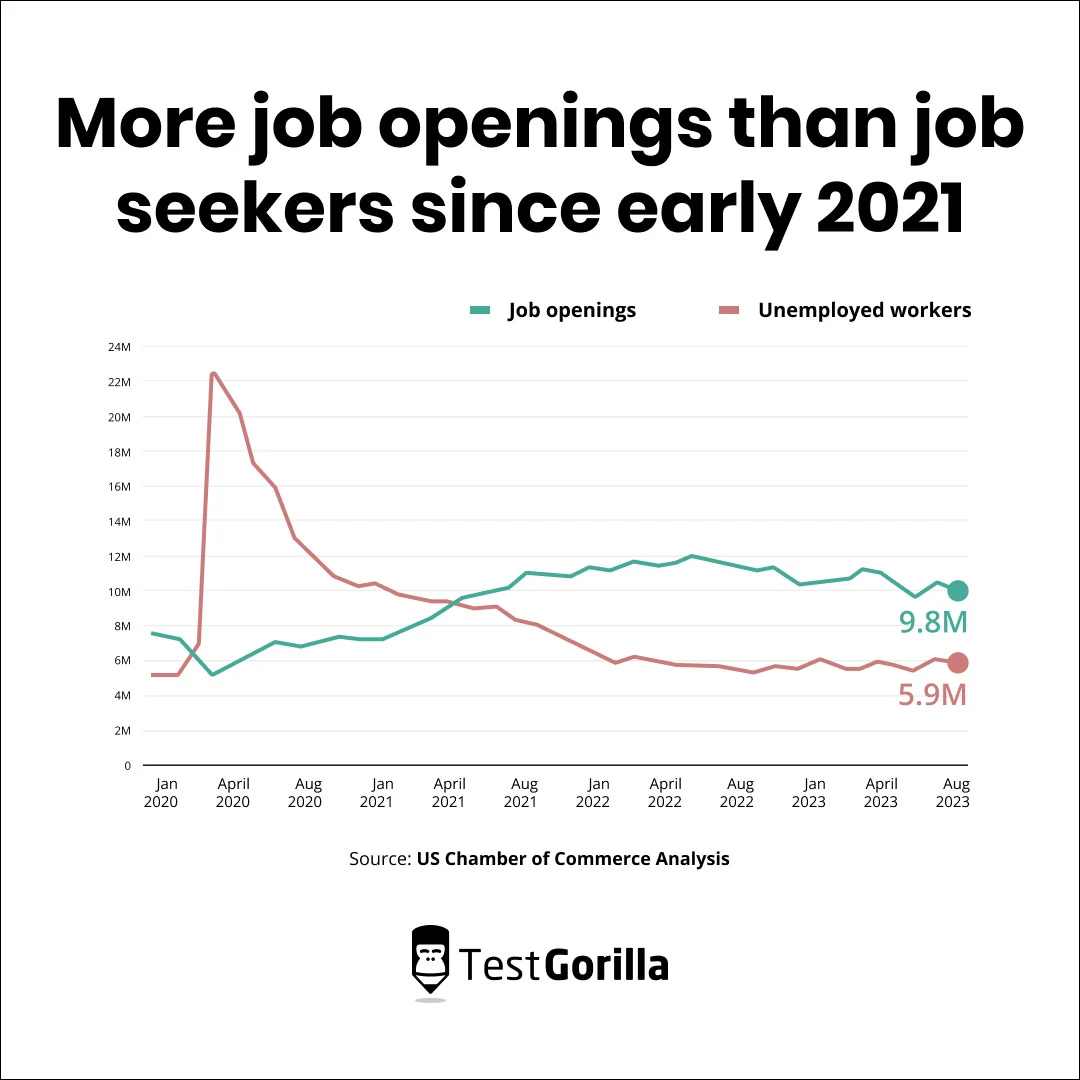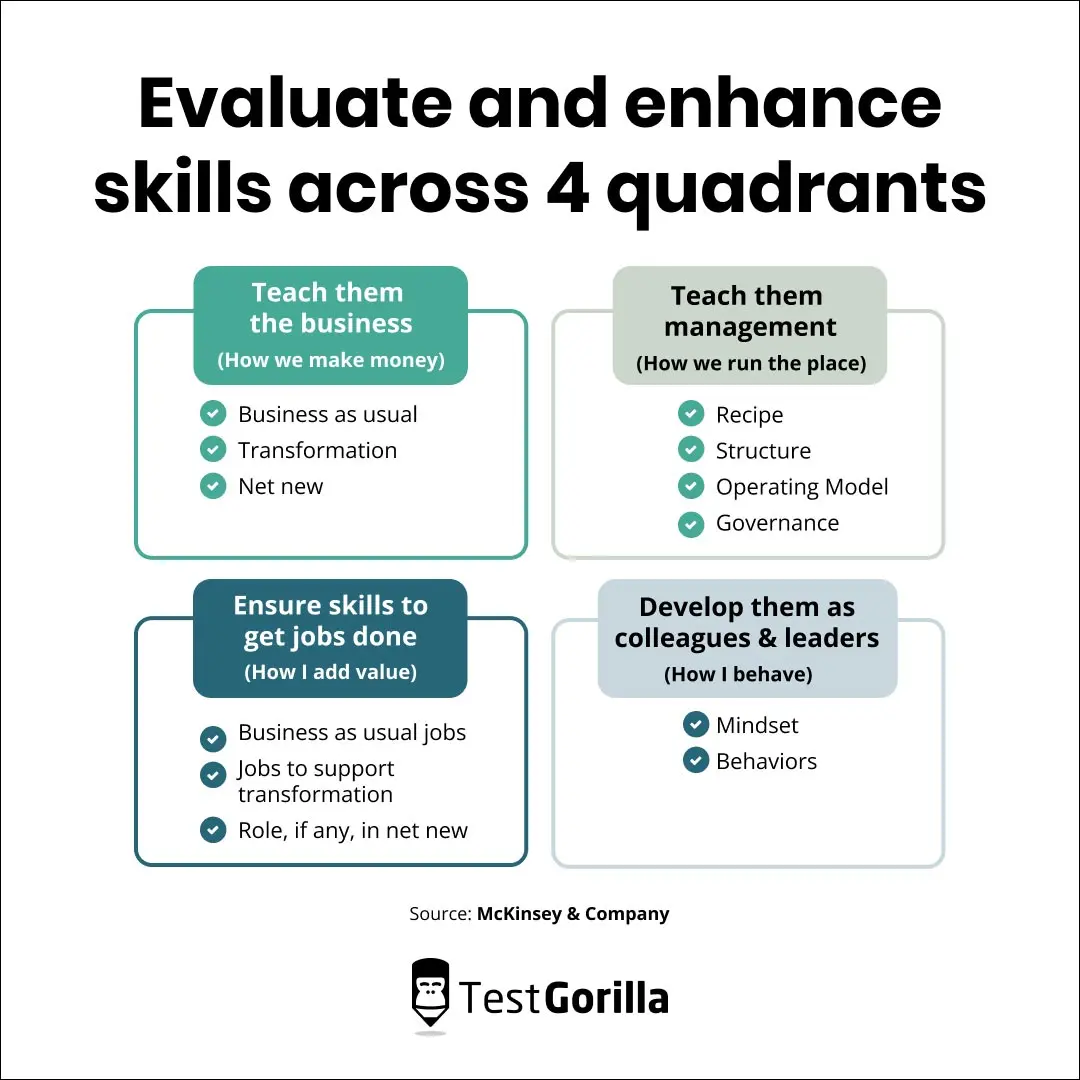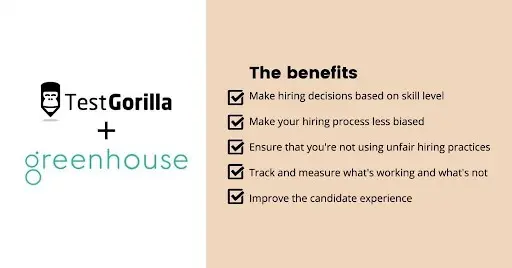The next decade is set to bring massive changes to the way we live and work.
The World Economic Forum predicts that 23% of jobs will change by 2027, with 69 million new jobs created and a whopping 83 million eliminated.[1]
Soft skill-intensive occupations will prosper, accounting for two-thirds of all jobs by 2030.[2]
Strong talent acquisition skills are vital for survival in this rapidly-evolving landscape. From identifying priorities for hiring to navigating emerging talent acquisition trends, employers need a finely tuned global talent acquisition strategy to hit the ground running.
But when so much is changing in the labor market, where do you get started with talent acquisition strategies?
In this blog, we cover the benefits of innovative talent acquisition strategies and deliver 26 actionable tips for developing a talent acquisition strategy for your business.
But first: What is a talent acquisition strategy, and why does your organization need one?
Table of contents
What is a talent acquisition strategy?
Talent acquisition strategy refers to the holistic, long-term approaches that organizations take to recruit top talent.
It’s not just about reactive recruitment, filling a role in response to a drop in performance or an employee resignation.
Instead, talent acquisition about proactively managing your HR function to reach specific big-picture business goals, even before the need for recruitment arises. That means:
Projecting an image of your organization that makes top candidates want to work for you
Exposing these candidates to opportunities at your company
Motivating talented people to apply to your open roles and ensuring their application experience is positive
Securing them as employees and ensuring they stick around for the long haul
Many organizations even have a dedicated talent acquisition team within their HR department, including roles like:
Talent acquisition specialists, who have a hands-on role in hiring
Talent acquisition managers, who oversee the planning and development of talent acquisition strategies
The head of talent acquisition, who runs the department and sets priorities
An example of one of these roles in action comes from the British restaurant chain Wagamama. The chain’s head of talent acquisition and employer brand has worked on projects including:
Implementing a new talent acquisition platform
Building an internal careers page to promote internal mobility
Renegotiating contracts with job boards to secure cost savings[3]
Talent acquisition vs. recruitment: What's the difference?
Talent acquisition and recruitment are distinct but overlapping concepts.
Talent acquisition strategy is a long-term, big-picture endeavor. It includes many tasks, some of which relate to recruitment, all of which work to attract talent to meet the business’s needs.
Recruitment, on the other hand, is usually short-term, targeting a particular role.
When thinking about the differences between talent acquisition and recruitment, it helps to consider the different tasks involved in each process:
Tasks involved in talent acquisition | Tasks involved in recruitment |
Hiring planning Developing a recruitment strategy Recruitment marketing Using talent assessment tools and recruitment tools Performing talent analytics Onboarding Succession planning | Sourcing candidates Screening applicants Screening resumes Interviewing Conducting talent assessments Selecting candidates Hiring |
Why are talent acquisition strategies important?
Talent acquisition strategies require that businesses first define what their overall objectives are and identify the skills necessary to deliver on those objectives.
This helps you with talent planning and particularly with succession planning: Your organization’s plan for replacing key leaders in the event that they leave.
It also gives you deeper insight into the skills needed by your departments to build teams that excel.
This is especially important now because, as we’ve touched on already, the 2020s are a challenging time for businesses.
In the aftermath of the Coronavirus pandemic and the Great Resignation, employers are operating in a candidate’s market. The number of job openings surpassed the number of unemployed workers in early 2021, making it harder for employers to attract talent.
The emergence of the candidate’s market has led to skills shortages. These shortages occur when the absence of a specific skill in a business is also true in the wider market, for instance regionally or in a certain industry.
In fact, in 2023, more than three-quarters of companies worldwide reported talent shortages, the highest number in 17 years.[4]
Skills shortages are especially concentrated in tech areas, like machine learning, due to the accelerated rate of technological change.
This all means that building a recruitment funnel that works has never been more challenging. Talent acquisition strategies like the ones set out below raise the profile of businesses and help them win the war for talent.
26 talent acquisition strategies for finding and hiring the right employees
To get out in front of the changes coming for the global workplace, you need the best talent acquisition strategies in place in your workforce.
We’ve assembled our top 26 innovative talent acquisition strategies into a comprehensive plan to help you attract the best talent and keep your organization on the cutting edge.
To do this, we’ve broken these strategies into four phases:
Organizational changes required for a strong talent acquisition strategy
Honing your talent acquisition processes
Diversifying your pipeline of talent
Making recruitment fairer and more effective
26 talent acquisition strategies: Summary
If you’re already in the process of developing a talent acquisition strategy and want to check if you’ve missed anything, don’t worry. Here’s a summary to help.
Talent acquisition strategy | Summary and examples |
Organizational changes required for a strong talent acquisition strategy | |
1. Define your corporate identity | Outline your company’s visual identity, culture, communication style, and corporate purpose |
2. Use employee input to guide a good company culture | Survey your employees about which traits they think are most valuable in your company culture |
3. Align your CSR strategy with your company mission | Pick a CSR strategy that extends your company mission into the nonprofit sector, similar to Salesforce’s 1:1:1 policy |
4. Stand out from competitors with strong learning and development initiatives | Offer every employee a personal training budget for them to direct their own learning |
5. Broadcast your company culture with strong employer branding | Broadcast key wellbeing policies in your recruitment marketing to illustrate your employees’ positive work-life balance |
Honing your talent acquisition processes | |
6. Engage in strategic workforce planning | Use skills testing to assess the skills of your current employees and decide which skills to target with recruitment |
7. Develop a capability building framework | Teach employees how your business makes money, how it’s managed, how they can add value, and how they can pursue personal development. |
8. Choose the best talent acquisition technology | Integrate skills testing software like TestGorilla with applicant tracking software (ATS) to understand your talent sources |
9. Use talent acquisition analytics to hone your processes | Identify diversity gaps and deploy additional outreach to diverse candidates for these roles |
10. Build a talent pool to get an overview of your talent pipeline | Create a database of potential candidates, for instance including past candidates who were rejected |
Diversifying your pipeline of talent | |
11. Embrace inclusive hiring practices | Strengthen your DEI talent acquisition strategies by removing degree requirements to enable STARs to apply |
12. Use campus recruitment to find candidates for early-career or research roles | Emphasize job flexibility when pitching to Gen Z because this is important for them when choosing a job |
13. Enlist your team members for virtual job fairs | Ask team members to socialize with candidates and use their insights to guide hiring |
14. Train up new talent by creating an internship program | Invest in hands-on training for interns by allowing them to work on key projects |
15. Organize a hackathon to unearth “hidden gem” candidates | Sponsor a hackathon to solve a business challenge and unearth potential programmer candidates |
16. Try passive recruiting by attending industry networking events | Reach out to candidates who aren’t currently on the job hunt – for example, by establishing yourself as an industry thought leader and building connections |
17. Activate your existing network with an employee referral program | Create added incentives for employee referrals – for example, gift card rewards for every referred candidate who makes it to interviews |
18. Use employee-generated content for social media recruiting | Share “Day in the life” videos created by your employees |
Making recruitment fairer and more effective | |
19. Promote equality of opportunity by hiring with talent assessment tests | Replace resume evaluation with skills testing to create a shortlist |
20. Assess applicants for culture add to find diverse candidates | Use TestGorilla’s Culture Add test to find candidates who share your vision while bringing diverse skills to the team |
21. Build structured interviews into your hiring plans | Ask all candidates the same questions, in the same order, judged by the same pre-agreed criteria |
22. Continue candidate relationship management, even after rejections | Proactively communicate with candidates at every stage, especially when rejecting candidates for roles |
23. Make compensation and benefits for every role publicly available | Create a portal on your website where candidates can view the salary for their role and all roles in the company to make salary negotiation fairer |
24. Follow onboarding best practices to reduce ghosting | Send future employees a personalized video from their team welcoming them to the company before they start to reduce the likelihood of ghosting |
25. Assess applicants for culture add to find the right candidates | Use TestGorilla’s Culture Add test to locate candidates who share your vision and bring diverse skills to your organization |
26. Choose the best candidate screening methods | Balance candidate quality and time to hire by choosing skills-based candidate screening methods |
1. Define your corporate identity
To build a strong talent acquisition strategy you must first define your corporate identity. That means how your business presents itself externally, including its:
Visual identity – for instance, its logo and color scheme
Corporate behavior – how it interacts with customers and clients
Company culture – the values that form its foundation
Communication – for instance, its tone on social media
Corporate purpose – what good the organization does in the world
Almost 40% of workers say their job or career is important to their identity, and yet more than half of workers don’t believe that a company’s corporate purpose drives their business decision-making.[5,6]
If you prove that your business is guided by purpose, you attract candidates who share these values, and they are likely to prioritize you over competitors.
Patagonia is a strong example. The company’s owner recently announced that all profits would go to fighting climate change, a powerful statement of its corporate purpose.[7]
No wonder, then, that it ranks in the top 100 most attractive employers in the US.[8]
2. Use employee input to guide a good company culture
With your corporate identity outlined, you can begin to craft a good company culture based around this shared mission and values.
Many employers will come to this blog with a workplace culture already established. In this case, work with your teams to identify the traits that they think make your organization different, and work to strengthen the link between your culture and your values.
This provides the cornerstone of your appeal for employees: 86% of job-seekers say company culture is important to them when deciding on a role.[9]
3. Align your CSR strategy with your company mission
So far, we’ve helped you identify:
Your corporate identity, or the “personality” your company is trying to convey
Your company culture, or the set of norms and values that govern how your employees work
To broadcast these messages about your values and mobilize your workforce for the greater good, align your corporate social responsibility strategy with your corporate identity.
Research shows that having a positive perception of an organization’s CSR policies makes that company more attractive to candidates.
One real-world example of a business aligning its corporate identity with corporate social justice is Salesforce. Salesforce’s 1:1:1 policy pledges 1% of its product, 1% of its equity, and 1% of employees’ time to communities and work in the nonprofit sector. The goal is using technology to solve problems for communities.[10]
This aligns with the organization’s business purpose and provides value for employees and communities.
4. Stand out from competitors with strong learning and development initiatives
Providing upskilling and reskilling opportunities may sound like a policy that primarily benefits existing employees.
However, a lack of learning and development initiatives is the number one reason people leave their jobs.[11] Offering development programs to your employees helps you stand out from the crowd.
In addition to attracting candidates, learning and development strategies maximize the value of your hires in a changing skills landscape.
Nearly 60% of the workforce already need new skills to do their jobs effectively; offering training opportunities ensures that new hires can adapt even if their roles shift.[12]
It also enables you to take on workers with incomplete or adjacent skill sets if you’re hiring during a skills shortage. This avoids the cost of hiring in-demand experts because you can use training to fill in the gaps.
At TestGorilla, we give every employee an individual development budget of 3% of their annual salary to use on training of their choice. Their spending just needs to be signed off by their manager.
5. Broadcast your company culture with strong employer branding
Now that you’ve strengthened employees’ connection to each other and to your organization’s mission and values, it’s time to build this into your employer brand. This plays a pivotal role in attracting new talent.
The key to strong employer branding is to foreground the EVP, or employee value proposition. In other words: What are the benefits of working for your organization?
At some organizations, such as startups, you could base your EVP on the autonomy and creativity you offer employees. At others, the EVP might be the chance to work from anywhere in the world on a remote contract. Although the concepts of an EVP and employer brand are closely related, the two have distinct differences. Check out our post on EVP vs. employer brand to learn more.
Google is a good example of a company with a strong employer brand. Known for innovation and flexibility, Google has several high-profile policies which project this image, for example, their office perks, like “nap rooms.”
The EVP for Google is that employees contribute to a creative work environment for a globally recognized brand, with autonomy over their workflow.
6. Engage in strategic workforce planning
Much of the work we’ve done so far is preparation for active recruitment. This is where strategic workforce planning comes in.
Strategic workforce planning is all about getting:
The right candidates
Into the right roles
At the right time for the organization
To do this, you need to first assess the skills of your existing employees.
You might do a general skills audit, or focus on teams that have been struggling to meet their targets. Hone in not only on core skills, but also on transferable and soft or power skills that facilitate collaboration and problem-solving.
Once this is done, conduct a skills gap analysis using the data you’ve collected and identify the holes in your workforce you need to fill. Then, draw up a timeline for recruitment.
7. Develop a capability building framework
Once you have data on the skills you’re missing in your organization, you can develop an action plan to bridge those gaps.
One way to do this is through capability building, or identifying and propagating the skills needed for the business to succeed.
McKinsey suggests this should be done in four key areas, teaching employees how:
The business makes money
The organization is managed
They can add value
They can develop personally
This effort to strengthen your existing workforce involves learning and development initiatives like the ones mentioned above. It may also include identifying key skills which cannot be nurtured in-house and must be brought in through external recruitment.
8. Choose the best talent acquisition technology
To acquire the best talent, it helps to use the best talent acquisition technology. The most recommended recruitment tools for human resources on the market include software like:
Applicant tracking systems (ATS), which help you keep track of current and past applicants
Internal talent marketplaces, which show the skills available within your organization
Testing software, like TestGorilla
The latter can be integrated with other recruitment tools to spread the benefit of skills test data across your hiring function.
For example, you can integrate TestGorilla with Greenhouse ATS as part of a successful talent acquisition strategy to better understand your applicant sources.
By cross-referencing ATS data with TestGorilla skills test results, you can see if your top-scoring candidates come from particular job boards or recruiters to better prioritize your spending.
9. Use talent acquisition analytics to hone your processes
Talent acquisition analytics refers to any data about your employees and processes that helps guide your hiring strategy.
You might draw your talent acquisition analytics data from a number of tools, including ATS, skills testing software, and recruitment marketing platforms.
There are many innovative ways to use data when developing a talent acquisition strategy, for example:
Recognizing that candidates sourced from one recruiting partner have a low success rate and reallocating your recruitment funds to more effective talent sources
Noticing that candidates tend to fall off after the first phone interview, so scrutinizing that process to improve it
Identifying diversity gaps in the workplace and deploying additional outreach to diverse candidates when hiring in these areas
10. Build a talent pool to get an overview of your talent pipeline
Your talent pipeline is best thought of as the journey candidates take toward employment at your business. It starts when they first hear of you – for example, on social media – and ends in employment at your company.
On their way, employees pass through your talent pool: a list of potential candidates in active consideration for open positions at your company.
To expand your talent pool and tap into the right talent when filling vacancies, you first need to get an overview of the candidates in your orbit. To do this, create a database including information for:
Any current applicants for positions at your company
Promising past applicants who have consented to staying in your system
Current employees eligible for internal promotion
Past employees you would be glad to see return to the organization
You might keep track of these in an applicant tracking system or an internal talent marketplace software.
This gives you a better view of your talent pipeline because it helps you keep track of potential candidates for upcoming roles and where they come from.
Depending on the recruitment tools you use, it can also help you stay in touch with potential candidates to stop them from falling off your radar.
11. Embrace inclusive hiring practices
Now that you’ve honed your acquisition strategy to attract talent, you should employ inclusive hiring methods to hire as diversely as possible.
Pay particular attention to diversity and inclusion if your company or industry is dominated by one group. For example, there are severe issues with underrepresentation in STEM.
One way to make your diversity and inclusion talent management more inclusive is by removing degree requirements.
This is a widespread trend known as the degree reset. It is driven by increasing awareness that valuable skills are kept out of the workforce because they are held by STARs, or workers skilled through alternative routes.
Opening your workforce to STARs diversifies your pipeline significantly because 60% of American workers aged 25 or older do not hold a four-year degree.
Increased diversity in your hiring brings benefits to your business outcomes.
Research shows that each 10% increase in intersectional gender equity achieves a 1%-2% boost in revenue for organizations; indeed, McKinsey analysis shows this relationship has only strengthened over time.[13,14]
12. Use campus recruitment to find candidates for early-career or research roles
Don’t worry: Doing away with degree requirements doesn’t mean ignoring graduates. They just won’t have an unfair advantage over STARs anymore.
Of course, some roles do still require degrees, and even if they’re not necessary, the skills candidates gain from university can be an asset.
With this in mind, campus recruitment is a great option when you’re hiring for research or technical roles, or looking for a highly targeted age demographic.
After all, Gen Z will make up more than a quarter of the workforce by 2025 – you need to connect with them early.[15]
The secret to successful campus recruitment is tailoring your approach. Be sure to foreground stability and salary when you pitch job descriptions to Gen Z because these are priorities for emerging graduates.[16]
Don’t forget to put a spotlight on your flexible working policies while you’re at it. One in four Gen Z workers says they work harder and stay longer at organizations with flexible schedules.
13. Enlist your team members for virtual job fairs
Particularly if you belong to a remote or hybrid workplace, hosting a virtual job fair is a great way to meet and evaluate potential talent and expand your global talent acquisition strategy.
There are many ways to approach this form of virtual recruitment. For instance, you might set up one-to-one meetings between candidates and hiring managers as a pre-screening process. You can also ask department heads to deliver short lectures on key projects.
The benefit of meeting candidates in this forum is that both parties get a better idea of their fit with your organization.
For best results, ask the teams you’re hiring for to participate and interact with candidates. Get their impressions of the available applicants and let this guide the recruitment process.
14. Train up new talent by creating an internship program
Internships get a bad rap sometimes. If the main appeal of hiring interns is to have someone to go on your morning coffee run and take meeting notes, it’s not the talent acquisition strategy for you.
However, if you’re willing to trust and train young recruits, creating an internship program brings fresh insight into your processes and extends your pipeline into a younger generation.
The tech company Asana has had great success with its internship program. At Asana, all interns are “technical interns,” and are considered to be core members of the team. Instead of working on low-risk projects alone, they contribute directly to product teams as a means of hands-on training.[17]
15. Organize a hackathon to unearth “hidden gem” candidates
A hackathon, sometimes referred to as a “codefest,” is an event where computer programmers from different backgrounds collaborate to solve problems or complete complex projects.
It is usually a company or educational body that organizes a hackathon, with the goal of solving business challenges and promoting innovation.
For example, Tickethon was a hackathon organized by Austrian transport company Wiener Linien to improve and speed up digital ticket validation on the WienMobil app.[18]
As well as providing value to your business, hackathons are also a great way to spot potential talent and programming skills that might have gone unnoticed due to recruitment barriers like degree requirements.
16. Try passive recruiting by creating thought leadership content
We know that passive recruiting sounds like a dream come true. That’s when you just sit back, and the best candidates come to you, right?
Not quite. Passive recruiting is when hiring managers proactively reach out to passive candidates who are not currently engaged in the job search.
One way to identify these candidates is to establish yourself or one of your senior executives as a thought leader in your industry.
You could do this through a podcast, like the Social Minds podcast by Social Chain Agency, where senior leaders discuss pressing topics in social media marketing.[19]
This approach has the dual benefit of not only attracting potential clients, but also professionals working in the same area.
You can then use these leads to reach out to promising candidates who already associate you with innovative ideas.
17. Activate your existing network with an employee referral program
One of the most effective talent acquisition strategies out there is the good old employee referral program.
Employee referral programs deliver more than 30% of all hires.[20]
For roles that are particularly difficult to fill, create added incentives for employees to refer qualified candidates. For example, you might offer gift cards for every referred candidate who makes it to the interview stage, regardless of whether they are eventually hired.
This encourages employees to think more creatively about who to recommend for job postings, while still ensuring candidates are qualified. It even bolsters your current employee engagement by involving them in the recruitment process.
18. Use employee generated content for social media recruiting
When you picture social media recruiting, you probably imagine the more in-your-face examples – brash messages from recruiters on LinkedIn, or punchy job ads on Facebook.
But your social media recruiting efforts can also be more subtle, using content generated by your current employees.
This could be a “Day in the life” video like the “life at Google” videos Googlers post on TikTok, or it could be as simple as asking employees to share their wins on LinkedIn under a company hashtag.
This brings some of the benefits of the employee referral strategies we discussed above, in addition to humanizing your organization to outsiders.
It also adds authenticity to the claims you make about your culture. It’s one thing to tell people that you have “generous family leave policies”; it’s another for a working parent to post about how your company is helping them raise their children.
This type of employee-led content helps candidates picture themselves at your organization, which makes you stand out on the job market.
19. Promote equality of opportunity by hiring with talent assessment tests
Traditional hiring tools like resumes are a minefield of bias.
Did you know that applicants with white-sounding names are almost 10% more likely than those with Black-sounding names to receive responses from employers – even from the same applications?
Replacing resumes with talent assessment tests takes human error like this out of hiring by giving hiring managers hard metrics to back up their hiring decisions.
Instead of looking at inaccurate indicators for new employees like university degrees or making snap decisions based on unconscious bias, talent assessments enable HR professionals to observe candidates’ performance in key skill areas.
This levels the playing field for all candidates and has been proven to bring big improvements for diversity.
One study of more than 2,000 successful job applications found that the number of women hired into senior roles increased by almost 70% when skills-based hiring methods were used.
20. Assess applicants for culture add to find diverse candidates
Talent assessments don’t only test hard skills, but also more intangible qualities like a candidate’s suitability for your all-important company culture.
At TestGorilla, we do this with our Culture Add test.
Whereas the traditional concept of “culture fit” relies on reproducing the existing characteristics of your team, our Culture Add test identifies candidates who share your organization’s values while also bringing something new to the makeup of your team.
This might be their unique combination of soft skills or their attitude to working.
Whatever diversity they bring, it has benefits for creativity on your teams: Deloitte research shows that diversity of thought increases innovation by about 20%.[21]
The Culture Add test is a huge asset when hiring diverse candidates. It ensures that even when your employees come from diverse backgrounds and ways of working, they are united behind a common vision, reducing conflict while maximizing innovation.
21. Build structured interviews into your hiring plans
If you’re following all, or even some, of the strategies set out above, you already have the workings of a strong hiring plan.
The next step is bringing this data-driven approach to the interview process.
Provide support to hiring managers during interviews by standardizing the interview process as much as possible using the structured interview approach.
Unlike traditional unstructured interviews, structured interviews require that interviewers ask all candidates:
The same questions
In the same order
Judged by the same criteria
This ensures that all candidates are evaluated on the core skills for the role and with minimal personal bias affecting the result.
Carve out time in your hiring plan to discuss questions with stakeholders and outline what a good answer looks like for your interviewers. You should also consider implementing a basic scoring system for panel interviewers to make it easier to compare candidates.
Although this may take more time prior to interviews, it shortens the decision-making process considerably post-interview, ultimately cutting your time-to-hire.
22. Continue candidate relationship management, even after rejections
Thanks to sites like Glassdoor, news travels fast when candidates have a bad experience during hiring. Research by the Human Capital Institute found that 72% of applicants share negative candidate experiences online.[22]
This means that candidate relationship management is more important than ever for preserving your employer brand.
Our top tips for candidate relationship management are to use a dedicated candidate relationship management system and to stay in respectful contact with candidates throughout the hiring process.
That means being proactive about candidate communication – even, or perhaps especially, when it’s a rejection.
The same Human Capital Institute research found that three-quarters of job-seekers never hear back from employers after applying for a role, so even an automated email goes a long way to set you apart from competitors.
23. Make compensation and benefits for every role publicly available
It’s pretty obvious that the best incentive for top talent to work with you is to offer compensation and benefits above the average for your industry – and, crucially, to state salaries in your job ads.
If your compensation and benefits packages are truly competitive, we also suggest making the salary for all roles available online.
This levels the playing field for diverse candidates, particularly those from lower socioeconomic backgrounds who might not have been prepared to negotiate for a competitive salary.
It also sends a signal of respect to candidates, reassuring top talent that they are not being short-changed when you offer them a role.
An example of an organization that uses this talent acquisition strategy example is software company Buffer, where salaries for all roles are visible on an open portal.
24. Follow onboarding best practices to reduce ghosting
Alas, ghosting doesn’t only happen in the dating world. Sometimes, you might be ghosted after interviews have taken place, or even after exchanging contracts, maybe even by a candidate you thought was a perfect fit.
One way to avoid this is to adhere to onboarding best practices by onboarding proactively from the moment you offer a role to a candidate.
Kick off your onboarding process by sending future employees a personalized video from their team welcoming them to the company.
This creates an unwritten social contract to discourage ghosting and creates familiarity and fondness for their colleagues before they even start, contributing to a wholly positive employee experience.
25. Assess applicants for culture add to find the right candidates
Talent assessments not only test for hard skills but also for intangible qualities like a candidate’s suitability for your all-important company culture.
At TestGorilla, we do this with our Culture Add test.
Whereas the traditional concept of “culture fit” relies on reproducing the existing characteristics of your workforce, our Culture Add test identifies candidates who share your organization’s values while also bringing something new to the makeup of your team, i.e., a unique combination of soft skills or their attitude to working.
This makes culture add a huge asset to inclusive hiring, ensuring that, even when your employees come from diverse backgrounds and have different ways of working, they are united behind a common vision, reducing conflict and maximizing innovation.
Deloitte research confirms the value of this approach by showing that diversity of thought increases innovation by about 20%.[21]
26. Choose the best candidate screening methods
Candidate screening is one of the most important parts of the hiring process, and it’s a shame that most companies boil it down to “scan resumes.”
Effective methods for screening candidates determine your candidate quality, impacting your recruitment budget and reducing mis-hires. The best screening methods also reduce your time to hire, which further affects your budget.
We recommend skills-based screening methods, such as using talent assessments, structured interviews, and job trials.
These methods show you the candidate’s real skills – and they do it quickly, streamlining your process with automation and data-driven decisions.
A quick example screening process would be evaluating candidates with talent assessments, taking the best to structured interviews, and then issuing job trials to your finalists.
Take a skills-based approach to your talent acquisition strategy with skills testing
The name of the game when developing a talent acquisition strategy is to be as proactive as possible.
Don’t wait for a role to open up in your team to set yourself apart from competitors.
With that said, we know that Rome wasn’t built in a day – we don’t expect you to have all 26 talent acquisition strategies in place tomorrow.
If you have to start somewhere, start by rolling out talent assessments across your hiring process as soon as possible. Strengthening your familiarity with skills-based hiring helps you when building a talent acquisition strategy more broadly.
To get an idea of what to expect over the coming years, check out our piece on the latest talent acquisition trends.
To find out how to avoid active recruitment and reduce turnover, read our blog post about talent retention.
Or dive in with strategy 20 and use our Culture Add test to hire the best.
Sources
1. “Future of Jobs Report 2023: Up to a Quarter of Jobs Expected to Change in Next Five Years”. (April 30, 2023). World Economic Forum. Retrieved July 27, 2023. https://www.weforum.org/press/2023/04/future-of-jobs-report-2023-up-to-a-quarter-of-jobs-expected-to-change-in-next-five-years/
2. O’Mahony, John; Rumbens, David. (May 2017). “Soft skills for business success”. Deloitte. Retrieved July 27, 2023. https://www2.deloitte.com/au/en/pages/economics/articles/soft-skills-business-success.html
3. “Simon Gomez”. LinkedIn. Retrieved July 27, 2023. https://www.linkedin.com/in/sjgomeztalent/
4. “The Talent Shortage”. (2023). ManPowerGroup. Retrieved July 27, 2023. https://go.manpowergroup.com/talent-shortage
5. Menasce Horowitz, Juliana; Parker, Kim. (March 30, 2023). “How Americans View Their Jobs”. Pew Research Center. Retrieved July 27, 2023. https://www.pewresearch.org/social-trends/2023/03/30/how-americans-view-their-jobs/
6. Gast, Arne, et al. (April 22, 2020). “Purpose: Shifting from why to how”. McKinsey Quarterly. Retrieved July 27, 2023. https://www.mckinsey.com/capabilities/people-and-organizational-performance/our-insights/purpose-shifting-from-why-to-how
7. McCormick, Erin. (September 15, 2022). “Patagonia’s billionaire owner gives away company to fight climate crisis”. The Guardian. Retrieved July 27, 2023. https://www.theguardian.com/us-news/2022/sep/14/patagonias-billionaire-owner-gives-away-company-to-fight-climate-crisis-yvon-chouinard
8. “Patagonia – Most Attractive Employers”. (September 8, 2021). Universum. Retrieved July 27, 2023. https://rankings.universumglobal.com/en/most-attractive-employers-top-100-tstdp-patagonia-united-states-business--2021/
9. “Job Seeker Nation Report: The Rise of the Optimized Workforce”. (2021). Jobvite. Retrieved July 27, 2023. https://media.trustradius.com/product-downloadables/EM/T5/Z3P0QKQTWLIN.pdf
10. “Pledge 1%”. Salesforce. Retrieved July 27, 2023. https://www.salesforce.org/about/pledge/
11. “2019 Retention Report”. (2019). The Work Institute. Retrieved July 27, 2023. https://info.workinstitute.com/hubfs/2019%20Retention%20Report/Work%20Institute%202019%20Retention%20Report%20final-1.pdf
12. Baker, Mary; Zuech, Teresa. (February 4, 2021). “Gartner HR Research Finds 58% of the Workforce Will Need New Skill Sets to Do Their Jobs Successfully”. Gartner. Retrieved July 27, 2023. https://www.gartner.com/en/newsroom/press-releases/2021-02-03-gartner-hr-research-finds-fifty-eight-percent-of-the-workforce-will-need-new-skill-sets-to-do-their-jobs-successfully
13. “Accenture Makes Strategic Investment in Pipeline to Accelerate Gender Parity in the Workplace”. (August 6, 2021). Accenture. Retrieved July 27, 2023. https://newsroom.accenture.com/news/accenture-makes-strategic-investment-in-pipeline-to-accelerate-gender-parity-in-the-workplace.htm
14. Dixon-Fyle, Sundiatu; Hunt, Dame Vivian; Prince, Sara. (May 19, 2020). “Diversity wins: How inclusion matters”. McKinsey. Retrieved July 27, 2023. https://www.mckinsey.com/featured-insights/diversity-and-inclusion/diversity-wins-how-inclusion-matters
15. Bloomgarden, Kathy. (May 19, 2022). “Gen Z and the end of work as we know it”. World Economic Forum. Retrieved July 27, 2023. https://www.weforum.org/agenda/2022/05/gen-z-don-t-want-to-work-for-you-here-s-how-to-change-their-mind/
16. “The class of 2023 forges ahead”. (August 2022). Handshake. Retrieved July 27, 2023. https://joinhandshake.com/wp-content/uploads/2022/12/Aug_22_HNT_PDF_report_revised221206.pdf
17. Rybicki, Steven. (September 25, 2018). “The things we built: Meet our 2018 summer intern class”. Asana Blog. Retrieved July 27, 2023. https://theworkback.com/2018-summer-intern-class-2/
18. Mendes, Carlos. (November 5, 2021). “4 Company hackathon examples to learn from”. Takai. Retrieved July 27, 2023. https://taikai.network/blog/four-amazing-company-hackathon-examples
19. “Social Minds - Social Media Marketing”. Podfollow. Retrieved July 27, 2023. https://podfollow.com/social-minds-social-media-marketing/view
20. Maurer, Roy. (June 23, 2017). “Employee Referrals Remain Top Source for Hires”. Society for Human Resource Management. Retrieved July 27, 2023. https://www.shrm.org/resourcesandtools/hr-topics/talent-acquisition/pages/employee-referrals-remains-top-source-hires.aspx
21. Bourke, Juliet. (January 22, 2018). “The diversity and inclusion revolution: Eight powerful truths”. Deloitte Review. Retrieved July 27, 2023. https://www2.deloitte.com/us/en/insights/deloitte-review/issue-22/diversity-and-inclusion-at-work-eight-powerful-truths.html
22. “Statistics: Rethink Your Candidate Experience or Ruin Your Brand”. (October 1, 2018). Human Capital Institute. Retrieved July 27, 2023. https://www.hci.org/blog/statistics-rethink-your-candidate-experience-or-ruin-your-brand
Related posts
Hire the best candidates with TestGorilla
Create pre-employment assessments in minutes to screen candidates, save time, and hire the best talent.
Latest posts
The best advice in pre-employment testing, in your inbox.
No spam. Unsubscribe at any time.

Hire the best. No bias. No stress.
Our screening tests identify the best candidates and make your hiring decisions faster, easier, and bias-free.
Free resources
This checklist covers key features you should look for when choosing a skills testing platform
This resource will help you develop an onboarding checklist for new hires.
How to assess your candidates' attention to detail.
Learn how to get human resources certified through HRCI or SHRM.
Learn how you can improve the level of talent at your company.
Learn how CapitalT reduced hiring bias with online skills assessments.
Learn how to make the resume process more efficient and more effective.
Improve your hiring strategy with these 7 critical recruitment metrics.
Learn how Sukhi decreased time spent reviewing resumes by 83%!
Hire more efficiently with these hacks that 99% of recruiters aren't using.
Make a business case for diversity and inclusion initiatives with this data.





















